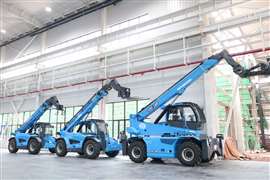A good deal? Jeff Eisenberg on United Rentals' latest acquision
23 April 2014

United Rentals has acquired US rental company National Pump & Compressor for a price of US$780 million, equivalent to 3.7 times National’s 2013 revenues. Jeff Eisenberg asks, was it a good deal, and what does the price mean for United and the rest of the industry?
United’s press release on the National Pump acquisition used carefully chosen words. The first sentence focused on “financial returns throughout the cycle” which shows a desire for United not to be seen as a cyclical rental company tied to the peaks and troughs of construction.
Fifty percent of National’s revenue comes from the energy sector. National Pump was founded in 2007, and United Rentals was happy to report it has grown at over 50% per year since 2010. United’s own business is growing at around 6 to 7% a year.
In the ‘Private Equity Wakes Up’ article in IRN’s February 2014 issue, nearly all the recent private equity acquisition analyses disclosed very little information, sometimes not even the acquisition value. As United Rentals’ shares are traded on the New York Stock Exchange it has many investors. United has to maintain its credibility with these owners, and it has had its own ups and downs in the past. In 2008 it famously wrote off more than US$1 billion in acquisition goodwill. This makes both United and its shareholders wary of overpaying for rental company acquisitions.
Valuation methods
The enterprise valuation method makes it easy to compare different rental companies with different depreciation policies and debt levels. Most other valuation methods focus on profit, but in rental businesses profit is heavily influenced by depreciation policy and replacement cycle for rental fleet.
A company is more valuable the higher its cashflow, provided it can handle its debt. The enterprise value of a company is a multiple of the operating cash flow (Earnings Before Interest Tax Depreciation Amortisation or EBITDA). The price to acquire a company is usually the enterprise value minus its debt. The equipment lease portion of a company’s debt usually continues with the new owner.
EBITDA multiples range from perhaps three to nine, depending on the growth rate and cash generation capacity of the company, its market position and desirability, and the certainty of its growth and cashflow.
Which multiple?
In good times, pre-2008 financial crisis, many acquisitions of rental companies seemed to average six times EBITDA minus debt. Why six and not four, or eight?
The banks seemed to be able to handle four times EBITDA as the loan to acquire the company, so an equity investor could buy a business using this loan plus another two times EBITDA. This worked fine as long as debt was available, and the companies could profitably, reliably “outgrow their debt” with growing cashflow.
Unusually in this case, United has given information including National Pump’s 2013 revenue ($211 million), historical growth (50% per year from 2010 to 2013), EBITDA at 49% of revenue, and even the relationship between rental revenue and equipment original cost (dollar or financial utilisation at 80%). Very unusually, United has said it has “plans to double the size of the pump business in five years.”
If we project the value of the acquired company on today’s profitability, dollar (financial) utilisation, at the “double in five years” growth rate, which is around 15% compound per year, we can try to see if the company will grow in value (see graph).
The answer is yes, mostly because the financial utilization (80%) and EBITDA (49%) are unusually high compared to most rental companies, and indeed to the rest of United Rentals’ performance.
Of course, looking at these things from the outside you can never see the whole picture, but with some reasonably conservative assumptions, such as that National Pump – which previously grew at 50% per year - now only needs to grow at 15% at the same profitability and investment rate to continue to be sustainable, even supporting its high acquisition price.
This is even before the factor in synergies between National Pump and United. These could include renting National Pump equipment through United’s vast depot network and customer base; using United Rentals’ lower cost of capital; and savings on costs by merging overlapping depots. This, plus any efficiencies that National Pump might gain as revenue continues to grow (hopefully faster than its overheads).
In conclusion, while the headline price is very high compared to National Pump’s revenue, it is an exceptionally cash generative company, which has been growing more quickly than most of the industry and indeed more quickly than United.
Does this mean that all rental companies are worth 7.8 times EBITDA and not four, five or six? The answer is that it depends, especially on the likelihood the acquired company will grow rapidly and profitably. Enough unusual, dependable growth and high cash flow can justify even exceptionally high company valuations.
The author: Jeff Eisenberg has spent 18 years in the equipment and rental industry. He started and led Genie Financial Services in Europe, providing finance for large and small rental companies all over the world. Since 2000 he has held senior positions in a number of European rental companies, as well as working with startups and acquisitions. He now provides consulting services to financial institutions, equipment manufacturers and rental companies. Contact Tel: +44 7900 916933, E-mail: jeff@claremont-consulting.com






